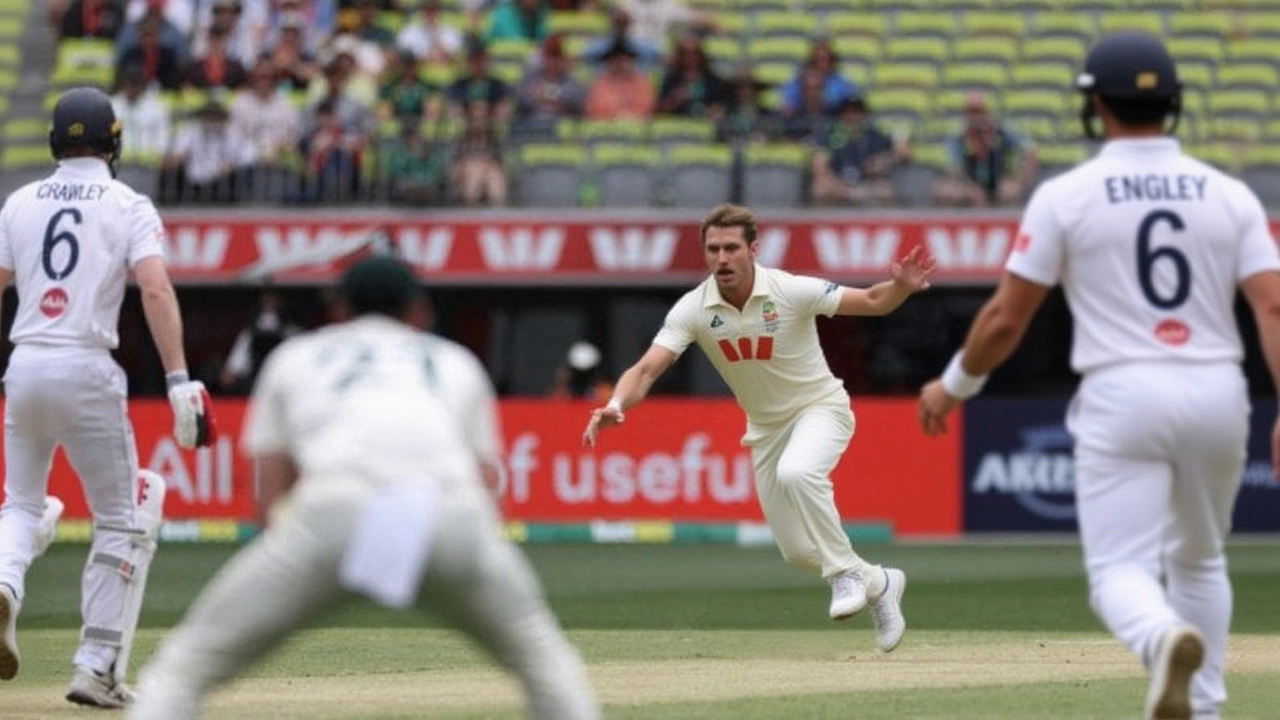Starc’s Diving Catch Ends Crawley’s Pair in Stunning Ashes Moment

- Kieran Montague
- 23 November 2025
- 0 Comments
On the second day of the first Ashes Test at Optus Stadium in Perth, Mitchell Starc didn’t just take a wicket—he made history with a catch that stopped the stadium breathless. At 35, the Australian left-arm pacer leapt sideways, fingertips grazing the turf, snatching a one-handed return catch off Zak Crawley’s feeble push on the fifth ball of England’s second innings. Crawley, dismissed for a duck in the first innings, was out for a pair. The crowd roared. The England bench froze. And Starc? He just nodded, as if this was Tuesday at the nets.
From 132 to 172: The Backdrop of Chaos
It wasn’t supposed to be like this. On Day 1, Australia, after winning the toss, were bowled out for 132. England, by contrast, scraped to 172, thanks to a late-order surge. But the real story was the collapse. After lunch, England lost six wickets for 67 runs. The final five tumbled for just 12. It was a batting implosion that looked more like a training drill gone wrong than a Test match. And at the heart of it? Starc. His 7-58 in the first innings wasn’t just good—it was surgical. He removed Joe Root, Ben Stokes, Ben Duckett, and four others. Root’s dismissal was especially symbolic: Starc’s 100th Ashes wicket. Root, the world’s top-ranked Test batter, still hasn’t scored a century against Australia on home soil.The Catch That Broke England’s Spirit
When Crawley stepped out on Day 2, he knew the script: survive the new ball, weather the storm. He didn’t survive five balls. Starc’s first delivery was a searing inswinger—Crawley left it. The second, a wide outswinger—he edged it, but the keeper missed. Third, a yorker—he defended. Fourth, a short ball—he pulled it to midwicket. Fifth? A back-of-a-length delivery, angling in. Crawley, expecting pace, tried to guide it square. Instead, the ball fizzed back toward the bowler, low and fast. Starc didn’t hesitate. He threw himself left, arm outstretched, hand snatching the ball like a hawk grabbing a mouse. The ball barely kissed his fingertips before he rolled, cradling it like a baby. The third umpire, Sharfuddoula, reviewed three angles. No doubt. Out.“That’s not a catch,” said one former England captain on live TV. “That’s a miracle.”
It was Starc’s 24th time taking a wicket in the first over of a Test. And the first time he’d dismissed the same batter in the first over of both innings in the same match. Crawley had lasted 23 balls in the first innings. Five in the second. The difference? Starc’s rhythm, his timing, his sheer refusal to let England settle.

Why This Matters Beyond the Scoreboard
The Ashes isn’t just cricket. It’s history. It’s legacy. It’s a series that began in 1882 after a satirical obituary declared English cricket “dead.” Now, 143 years later, Starc is writing his own chapter. His 100 Ashes wickets place him among the elite—only 11 Australians have reached that mark. He’s the first left-arm quick to do it. He’s the oldest Australian to take seven wickets in an innings since 1975. And he’s doing it with a body that’s been through more surgeries than most players have had hot dinners.“It’s not about fitness,” said former Australian captain Ricky Ponting on Cricket Live. “It’s about nerve. Starc doesn’t just bowl—he anticipates. He sees the batter’s fear before the batter does.”
England’s batting lineup, once considered a strength, now looks brittle. Crawley’s pair is the first by an England opener in an Ashes Test since 2013. The pressure on the middle order—Duckett, Root, Stokes—is now unbearable. Australia, despite being bowled out for 132, now lead by 40 runs. But more than runs, they lead in momentum. In spirit. In belief.

What Comes Next? The Test’s Turning Point
With England at 12 for 1 in their second innings after Crawley’s dismissal, the question isn’t whether they’ll survive the day—it’s whether they’ll survive the series. Starc has bowled 32 overs in the match. He’s still running in like a man half his age. The pitch, still offering pace and bounce, favors him. Australia’s captain, Pat Cummins, has two spinners ready. But he knows: Starc is the match-winner.If England lose this Test, it’ll be their first Ashes defeat in Perth since 2013. If they win, it’ll be a miracle. And if Starc takes another five wickets? He won’t just be the hero of this match—he’ll be the defining figure of this Ashes series.
Frequently Asked Questions
How rare is it for a batter to be dismissed for a pair in both innings of an Ashes Test?
Only 12 times in Ashes history has an opener been dismissed for a pair in both innings of a Test. The last was England’s Michael Carberry in 2013 at Adelaide. Crawley’s pair is especially notable because he was dismissed in the first over of both innings—a feat never before recorded in Ashes history. It highlights not just his struggle, but Starc’s dominance.
What makes Starc’s 100th Ashes wicket so significant?
Starc became the 11th Australian and the first left-arm fast bowler to reach 100 Ashes wickets. He’s also the oldest Australian to take seven wickets in an innings since 1975. His 100th came against Joe Root, the world’s top-ranked Test batter, making it a symbolic passing of the torch. Only Shane Warne and Glenn McGrath have more Ashes wickets than Starc among Australian bowlers.
Why is Optus Stadium such a tough venue for England?
Since 2004, England has won just one Test at Optus Stadium, and that was in 2013. The pitch is known for its pace, bounce, and early seam movement—perfect for pace bowlers like Starc. England’s batting has collapsed here in three of their last four tours. The stadium’s dry conditions and high altitude also make the ball swing and seam more unpredictably, a nightmare for overseas batters.
How does Starc’s fitness at 35 compare to other fast bowlers?
Few fast bowlers maintain elite pace into their mid-30s. Starc, who has battled stress fractures and hamstring injuries, runs in with the same aggression as a 22-year-old. His average speed in this Test: 148 km/h. Only Pat Cummins and Josh Hazlewood have bowled quicker in this series. His recovery between overs is faster than most pacers half his age, a result of meticulous strength work and ice therapy routines developed with Cricket Australia’s sports science team.
What’s the historical context of this Ashes series?
The Ashes dates back to 1882, born from a mock obituary in The Sporting Times after Australia beat England at The Oval. Since then, Australia has won 34 of the 73 series played. England’s last series win in Australia was in 2010–11. This match marks the first Ashes Test in Perth since 2021, and Australia has won the last six at Optus Stadium. The pressure is mounting on England to break that streak—and Starc is making sure they don’t.
What’s next for Mitchell Starc and Zak Crawley?
Starc is now just 17 wickets away from becoming Australia’s all-time leading Ashes wicket-taker, surpassing Glenn McGrath’s 197. For Crawley, this pair may be the turning point. He’s averaged just 14.2 in his last 10 Test innings. England’s selectors are already discussing a potential replacement, possibly Will Jacks or Harry Brook. But for now, the spotlight remains on Starc—bowling, catching, and commanding the stage like no one else can.


